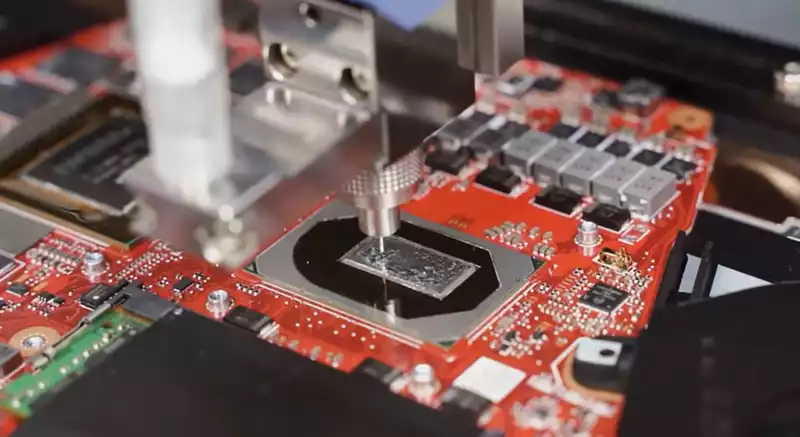Some thermal interfaces (the critical adhesive between the CPU and heatsink) are easy to apply while others are not, and liquid metal usually requires careful manual application. As a result, it is not often seen in mass-assembled notebooks, but Asus has figured out how to automate the application of liquid metal and plans to include it in upcoming ROG gaming notebooks.
Thermal compounds, regardless of their type, are designed to fill the microscopic irregularities on the surface of heatsinks and processor-embedded heatspreaders. They are also conductive, allowing more efficient heat transfer from the CPU to the cooler.
Liquid metal is preferred by some overclockers, especially those who "derid" (the delicate process of removing the integrated heatspreader and applying compound directly to the die) desktop CPUs. Asus has it on their ROG gaming laptops mobile CPUs without delidding (mobile chips have no IHS) and using "proprietary processes and machines" that can apply liquid metal on a large scale.
Will it really make a difference? That remains to be seen, but Asus claims that the change to liquid metal results in significantly lower temperatures.
"Liquid metals have a low melting point and are fluid at room temperature. Because they are highly conductive, these alloys are very effective at transferring thermal energy between surfaces such as the processor die and the heatsink. This advantage is well known in the overclocking and DIY world, and our in-house testing has enhanced their appeal for gaming laptops. Our engineers have seen temperature reductions of 10-20°C depending on the CPU," Asus explained in a blog post.
Asus stated that it uses Thermal Grizzly's Conductonaut, a popular option among overclockers, but chose not to partner with the company to keep the project secret.
"There are many different types of liquid metal on the market. We use Thermal Grizzly's Conductonaut because it has a lower concentration of tin, which is not as conductive as the gallium and indium that make up the alloy. We did not work closely with Thermal Grizzly as we do with other partners, but rather casually purchased the first quantities in order to keep the project confidential. During development, not even Intel knew about our plans," Asus says.
While Asus may seem a bit inflected, it is interesting to get a glimpse of their business. What intrigues me most is the actual application process Asus has designed. It is a two-step method that begins with a mechanized arm wetting a brush with a container of liquid metal and sliding it back and forth over the CPU. I am reminded of Daniel Larusso painting Mr. Miyagi's fence. The mechanized arm makes exactly 17 passes.
According to Asus, this method is not feasible for AMD processors. Intel CPUs have a limited area around the die with no capacitors, and the sponge "fills this space properly." However, in "other processors" (e.g., AMD Ryzen), surface mount circuitry is in the same space, and applying liquid metal would cause a short circuit.
According to Asus, ROG laptops with liquid metal will be available this quarter.


Comments